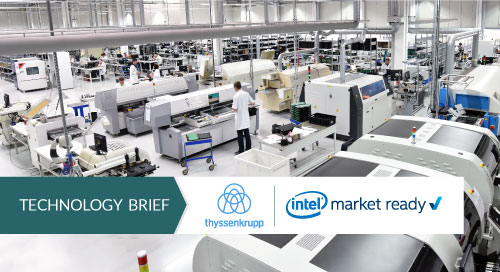A Full-Service Ecosystem Builds the Smart Factory

For manufacturers whose factory floors still rely heavily on manual processes, embarking on the path to digitalization—and the increased efficiency it brings—is the right direction. But wanting to build a smart factory and actually doing it are very different things.
With machine outfits from the 1950s to today, but no common language between them, and a lack of insights into their functioning, efficiency gains are impossible. And the limited number of partners who are genuinely equipped to help manufacturers deploy optimal solutions complicates matters even more.
“You have the consultants who identify problem areas and how to leverage the IIoT to fix them. You have the IT people who code. And you have the hardware people who install sensors and edge computing devices,” says Sebastian Lang, Chief Sales Officer at thyssenkrupp Materials IoT GmbH.
What manufacturers really need is a partner skilled in all three dimensions, who has deep knowledge of machines and the manufacturing process, who can identify how and where digitalization can help, and who can install and service the tools required to get there.
A Smart Factory Starts Small
Building on decades of experience, thyssenkrupp Materials IoT GmbH developed the toii Industrial Internet of Things Platform to meet manufacturers where they are—typically at the beginning of their digital transformation—and accompanying them along their journey.
“Many manufacturers don’t know yet what they want to achieve with their smart factory efforts—whether they want to fully automate control of their machines or just have access to their data,” says Joerg Plenert, CEO of thyssenkrupp AG. And if they want to start small, the bigger, more expensive solutions on the market are overkill.
On the other hand, in return for a small upfront investment and a reasonably priced ongoing subscription, toii gives manufacturers real-time insights into machine downtimes and failures, and the reasons behind them—critical information when increased efficiency is the goal.
“One key enabler is that our monthly subscription cost for the toii modules reflects customers’ business cases. We make sure that they earn an attractive multiply,” says Lang.
For example, when an expensive machine that should be running at all times has stopped the line, is it because it’s being set up for its next process? Or because material is missing or something is broken? toii can convey this information in the simplest way possible: visually, with a series of lights.
And over time, that kind of data is gold. “If you discover you’ve had many unexpected breakdowns over the last year, you can think about your maintenance strategy,” explains Lang. “If you often find that materials are missing, you can address your materials flow. And if the setup process is taking too long, staff can be trained on a quicker way.”
The platform is an elegant tool for companies just starting their journey toward a smart factory. But with a range of different modules to choose from, it’s also highly scalable. So when manufacturers want to increase the pace of their efforts, they can (Figure 1).

Manufacturers don’t know what they want to achieve with their smart factory efforts—whether they want to fully automate control of their machines or just have access to their data.
@thyssenkrupp
Cutting Production Setup Times
thyssenkrupp Materials Processing Europe, a steel processing company within the thyssenkrupp group, was looking for just this kind of flexibility when it decided to optimize its coil slitting operations in Stuttgart, Germany. The company wanted to update processes, and ultimately automate machine control. So it partnered with thyssenkrupp Materials IoT GmbH to figure out where to start.
After their initial consultation, the companies discovered the main barrier to efficiency was the time it took to set up the machines for slitting, a process that’s repeated for each new coil. With machines that spoke different languages and had no communication among them, the process of measuring the coils for thickness and width was essentially a manual one, extending setup times significantly.
“It became quite clear that we needed to automate the measurement step,” notes Plenert. “They already had well-functioning machines and sensors in place to do the actual measuring. They just needed the machines to be able to talk to each other in order to do it fast.”
Connecting the full range of machinery to the toii platform—and the automation it made possible—reduced downtimes by more than 10 percent. But there were other benefits, too. For example, the solution’s intuitive interface has allowed employees to replace time-consuming handwritten procedures with more accurate digital ones—freeing them for other important work.
A Seamless Journey to Industry 4.0
The integrated machine data that the toii solution provides is only part of an end-to-end service thyssenkrupp Materials IoT GmbH offers, which includes expert-level support at every stage.
Before each customer deployment, consultants with deep knowledge of manufacturing and the IIoT are brought in to determine the overall solution that will provide the most value. After the use cases are identified, field engineers handle installation on the factory floor. And once software engineers have configured toii specifically for the customer, the company provides ongoing support.
Such white-glove service helps manufacturers wherever they are on their journey to digital transformation.
But the speed of their progress also depends on having the right tools. “Visualizing and analyzing vast quantities of machine data at the edge requires powerful computing resources,” says Plenert. “Intel® is the best in this space. It’s why we’ve partnered with them, and why we encourage our customers to use their products, too.”
Once all the requisite tools are in place, the rest of the journey often follows the same path. “After a manufacturer sees what can be done with the smaller toii modules, they always want more,” notes Plenert. So what starts small, with gathering and visualizing data, can end with a fully automated factory floor, more efficient production lines, and a competitive edge.